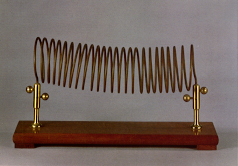
22.5 x 42 x 10.3
Wood, copper and brass
CAT. 1878 : 475
Solenoide.
Solenoid.
Ampère called the systems of infinitely small circular currents, infinitely close to one another, solenoids or electrodynamic cylinders. These currents must run in the same direction and each one is on a plane perpendicular to a common line, which may be straight or curved. The configuration thus obtained was particularly interesting, and the theoretical model proposed by Ampère led to the properties of magnets being explained on the basis of the circular currents of their "molecules". A magnet was nothing more than a bundle of minuscule solenoids arranged longitudinally. To illustrate the magnetic properties of solenoids and their similarity with magnets, Ampère built artificial solenoids using copper wire wound in a coil.
With the copper wire coils suspended between two supports, without friction, one can observe the orientation of the device along the magnetic meridian; its behaviour is identical to that of the magnetic declination needle. Magnetic dip is observed, however, once the solenoid, oriented along the magnetic meridian can rotate on a vertical plane, around its normal axis.
Ampère's experiments showed that two solenoids have a mutual effect of attraction or repulsion, depending on the proximity of their North and South poles. Behaviour analogous to this is observed when a solenoid is placed close to a magnet.
The solenoid in the Gabinete de Física was acquired in mid -19th century.
Daguin, Pierre-Adolphe, Traité Élémentaire de Physique Théorique et Expérimentale, Paris, 1878, Vol. III, n.º 641-708.